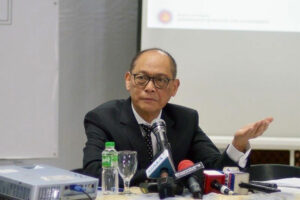THE Philippines’ credit rating is not expected to worsen, with officials presenting the case to the rating agencies for an upgrade because of the attainability of the country’s growth targets, the Department of Finance (DoF) said in a statement on Wednesday.
The DoF was quoting remarks delivered on Aug. 10 by Finance Secretary Benjamin E. Diokno in an appearance on a public affairs program.
“I think we are very confident that there will be no downgrades. In fact, it is notable that despite the two-year pandemic, the rating agencies have affirmed our investment-grade rating, and downgraded nearly one-third of the emerging economies and even some developed countries. We’re confident that we have presented a medium-term fiscal plan, as stated by the President, that is credible and doable. So, we don’t expect any downgrade within the next few years. In fact, we are working on an upgrade,” Mr. Diokno said.
Fitch Ratings in February maintained the Philippines’ investment-grade “BBB” rating, but retained a “negative” outlook, flagging uncertainties surrounding medium-term growth and hurdles to bringing down debt.
A negative outlook means a downgrade is possible within the next 12 to 18 months.
S&P Global Ratings last affirmed the Philippines’ “BBB+” rating with a stable outlook in May 2021. Meanwhile, Moody’s last affirmed its “Baa2” credit rating with a stable outlook for the Philippines in July 2020.
In July, the Marcos administration unveiled its medium-term fiscal strategy, with a target of 6.5-7.5% gross domestic product (GDP) growth this year, and 6.5-8% starting next year until 2028.
It also seeks to bring down the debt-to-GDP ratio to 61.8% by the end of 2022, from 62.1% at the end of the second quarter. The ratio is expected to drop to 61.3% by next year and 52.5% by 2028.
On Tuesday, National Treasurer Rosalia V. de Leon told the Senate Committee on Ways and Means that the debt load is sustainable and resilient to external shocks because 75% of the debt is expected to be sourced domestically by year’s end.
In the first half, domestic debt accounted for 69% of the total, with the Treasury hoping to raise the share to 80% for borrowing in the second half.
“Because of our conscious practice of stretching our maturities, our debt portfolio provides sufficient time to expand our revenue base and our economy before principal payments fall due,” Ms. De Leon said.
“Only 11.1% of our debt (has) variable interest-rate terms, minimizing our exposure to interest-rate resetting in light of the interest rate normalizations observed locally and abroad,” she added.
Ms. De Leon said the borrowing requirement was reduced to P2.2 trillion this year from P2.5 trillion last year, with the government also aiming to gradually reduce the fiscal deficit from 7.6% this year to 6.1% next year, then to 3% by 2028.
With GDP growth averaging 7.8% in the first half, the economy in the second half would need to grow by 5.2% to attain the lower end of the end-of-year growth target, according to economic managers.
While Mr. Diokno acknowledged inflation as a hindrance to growth, he said inflation has peaked at 6.4% in July, the fourth consecutive month it exceeded the central bank’s target.
“As you know oil prices have started to go down. So, we expect inflation to start to decelerate towards the end of the year. And in fact, we are confident that inflation will be within our target range of 2-4% next year,” Mr. Diokno said.
At the same time, Mr. Diokno expects the peso to stabilize to P55 or even stronger against the dollar by year’s end.
“As you know, there’s usually an influx of overseas Filipino remittances towards the fourth quarter. The peso has actually stabilized and, in fact, it’s strengthening, and so I bet it will be around P55 by the end of the year,” Mr. Diokno said. — Diego Gabriel C. Robles
